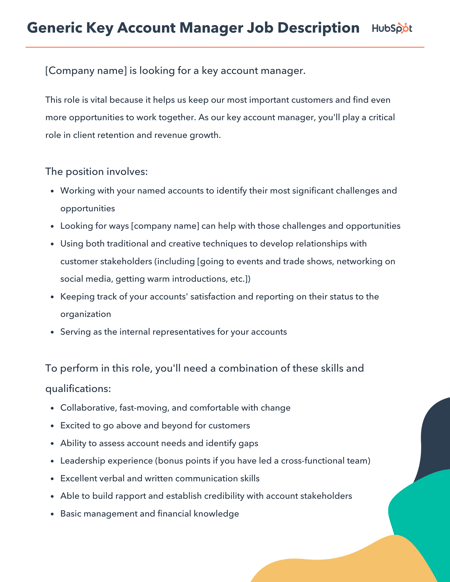Not all of your client accounts are equal. And it’s likely that a smaller percentage of these accounts are the ones that contribute the most revenue to your business.

As such, to maintain and even increase how much revenue your business can generate, you need to pay close attention to these key accounts — and that’s why you need a key account management process.
In this comprehensive guide to key account management, you'll learn:
-
What a Key Account is
The Benefits of Key Account Management
The Difference Between Key Account Management and Selling
How to Hire Key Account Managers (Including a Job Description Template)
Key Account Management Plan Template
Key Account Management Best Practices
What is a key account?
A key account can be considered one of your company's most valuable customers. These customers represent a disproportionate percentage of your revenue, refer new prospects to your company, give you credibility in their space — or all of the above.
However, the word "valuable" is subjective based on your organization’s values. For example, it could be based on any, all, or some of the following:
- Amount or share of recurring revenue they bring in
- The level of profitability you have with them (revenue taking into account cost)
- Customer lifetime value
- Level of influence and/or authority
- Number of referrals they make
- Level of alignment between shared goals (partnership)
Your organization needs an explicit, strict definition of key accounts. The more detailed and specific the criteria, the better — these customers will receive a great deal of your company's time, energy, and resources, so you want to make sure they're the right ones.
How to Identify Key Accounts
Don't choose solely based on revenue. Instead, review your current customers and their historical ratio of revenue to costs. Then, calculate how much potential there is to expand each account. You should also ask yourself whether they're a strategic partner, e.g., do they have the connections, resources, and/or industry reputation to significantly alter your company's trajectory?
You can use a key account scoring matrix to identify your key accounts across multiple criteria. Simply evaluate each account based on the criteria you select and assign them a score from 1 to 10 in each category. The accounts with the highest scores will be your key accounts.
SBI recommends choosing three to five selection criteria. Here's a list of examples:
- Product fit
- Solvency
- Existing relationships
- Possibility of becoming a channel partner
- Cultural fit
- Geographic alignment
- Purchasing process
- Revenue potential
While it's tempting to label many customers as "key accounts" at once to alter your company’s trajectory significantly, it’s better to be conservative. You can't tell a key account they've been demoted, but you can tell a traditional buyer you're promoting them.
In addition, you don't want to overcommit yourself. Starting a KAM program requires organization-wide change, support from the C-suite, hiring and training employees, and implementing new processes. Starting small allows you to focus your efforts.
Key Account Management
Key account management is the process of building long-term relationships with your company's most valuable accounts. These accounts make up the majority of the business' income. A key account manager (KAM) typically provides dedicated resources, unique offers, and periodic meetings to turn buyers into business partners.
As professional services firm BTS points out, key account programs often lead to increased costs and lower margins. That's the inevitable outcome of giving a customer greater resources and often your best discounts.
But if you use the right key account strategy, you'll reap greater sales volume and long-lasting strategic relationships.
The Benefits of Key Account Management
Why should you start a key account management program? Key accounts are responsible for 33% of sales revenue.

According to Gallop’s Analytics and Advice for B2B Leaders poll, organizations that excel at key account management and engage their customers see vastly improved account growth. Some of these benefits include:
- 34% more profitability than companies that don’t have a key account management process
- 50% more sales and revenue generated
- 33% greater chance of being their client’s top choice for future business
According to the Harvard Business Review, customer satisfaction increases 20% within a few years of starting a key account management program. Profits and revenue, meanwhile, can increase by 15%.
And programs that have been around for five-plus years can see results twice that.
Key Account Management Strategy
- How transactional your current sales process is.
- If your product has upsell and cross-sell potential.
- Your ability to ‘land and expand.’
- The competitive landscape you’re facing.
- Company capacity and resources.
Despite the potential benefits of key account management to your bottom line, it's not a good fit for every organization.
Consider the following points before you go all-in on a key account strategy.
1. How transactional your current sales process is.
If your sales cycle is relatively short and your sales reps have minimal interactions with prospects, key account management probably isn't the right choice. Key accounts require consultative selling techniques — and it will be hard to teach your salespeople to adopt entirely new processes for just a few clients.
2. If your product has upsell and cross-sell potential.
There's little point in continuing a relationship with the customer after the sale if they're not going to buy more. (Obviously, you still want to provide excellent customer service and support to promote word-of-mouth marketing and high retention rates.)
3. Your ability to 'land and expand.’
The above rule has an exception: If you can get your foot in the door of the prospect's company and then grow the account by selling to other departments, offices, subsidiaries, etc., a key account strategy may be a good investment.
4. The competitive landscape you're facing.
A key account program can serve as a competitive advantage. For example, imagine your customer has narrowed down their choice of vendor to you and one another company. If you can promise to make them a key account — and your competition can't do the same — you're likely to win the deal.
5. Company capacity and resources.
Successful key account management depends on company-wide support, executive buy-in, and a dedicated key account team. You'll also need enough runway for an investment that might take 12, 24, or 36 months to recoup.
Key Account Manager
The core role of a key account manager (KAM) is to handle the most valuable clients. They manage the account, build strong relationships with the client, identify challenges or opportunities, and find ways to assist with these challenges and opportunities.
A key account manager is responsible for managing and building a strong relationship with large clients who make up most of the business' income. Not only do KAMs find ways to address the client's challenges and opportunities, but they also create and present reports about the client's progress to key stakeholders.
The Difference Between Key Account Management and Selling
Key account management and selling are very different. While a salesperson focuses on the short term — by necessity — a key account manager (KAM) prioritizes the future.
Sales reps also zero in on specific opportunities, while KAMs have broader goals, including collaborating with the customer on mutually beneficial projects, helping the customer meet their objectives, and making sure the customer is getting the necessary support.
Key Account Management Skills
- Get to know the customer.
- Cross-functional collaboration to benefit the customer.
- Effective leadership of the key account team.
- Coordination and planning of activities for complex accounts.
- Strong business acumen.
- Ability to use analytical skills to support a variety of clients.
- Clear written and verbal communication skills.
Some companies assign their reps as key account managers to one or two customers. This setup isn’t ideal because selling and account management require different mindsets, skills, and objectives. Unless your team is prohibitively small, separate the sales and account manager roles.
A key account manager is focused on becoming critical to her customer's operations — not winning a deal.
Here are several unique skills critical to a key account manager's success:
1. Get to know the customer.
A key account manager must have an intimate, sophisticated understanding of her account's strategy, market position, finances, products, and organizational structure. Then, they’ll use this knowledge to make business cases showing how price changes, customization, and add-ons will add value.
2. Cross-functional collaboration to benefit the customer.
Key accounts don't usually buy off-the-shelf: They want a custom blend of products and services tailored to their needs. With that in mind, it's crucial a KAM can work across the organization to develop these offerings.
3. Effective leadership of the key account team.
A KAM needs leadership abilities to guide her team members (which might include a salesperson, marketer, technical support, implementation, and/or onboarding specialist).
4. Coordination and planning of activities for complex accounts.
Key account programs have a lot of moving parts. To be successful, KAMs should be capable of planning short-term and long-term plays, carrying them out, analyzing the outcomes, and applying those takeaways to their future strategies.
5. Strong business acumen.
A KAM should develop dynamic business acumen — an understanding of how a company makes money — to tell how its customers make money or keep tabs on any business changes.
With this knowledge, they'll be able to solidify their position as a trusted resource and advisor for their clients.
6. Ability to use analytical skills to support a variety of clients.
In addition to having business acumen, key account managers should have an analytical mindset. Their analytic skills will help them create and present business cases. They need to be able to think quickly and apply their knowledge to various clients and markets and be confident when presenting the information.
7. Clear written and verbal communication skills.
Key account managers are responsible for keeping clients and other stakeholders updated about any issues. Sometimes, these account managers are required to make oral presentations. As such, they need to be able to write and speak clearly.
Key Account Manager Job Description
Use this Key Account Manager job description to find and attract the most qualified candidates.

Key Account Management Plan Template
Download Your Free Template Here
According to RAIN Group, the most significant difference between high-performing companies and everyone else is an effective account planning tool.
A key account plan helps you identify the most significant possibilities for growth, potential roadblocks, threats from the competition, and more.
You can tailor an existing framework to your own needs or create a customized plan.
Whatever option you take, your account plan should include:
- Your relationships within the account
- The customer's current business plan, objectives, and financial health
- Your targets for the account
- Your strategy for hitting those targets
Let's delve into each of those in more detail.
Relationships
Map out every customer stakeholder. This information will help you figure out which relationships you need to build and maintain — as well as anyone who could potentially derail your plans.
Note each person's title, role in the decision-making process, how much contact you've had within them, and how "friendly" they are.
Customer's Business
To provide value to the account and find mutually beneficial opportunities, you need an in-depth, sophisticated understanding of their business.
Stay up-to-date on their key business goals, financial health, and current initiatives. You should also regularly run a SWOT (Strengths, Weaknesses, external Opportunities, external Threats) analysis.
Account Goals
This section should cover how much this account is currently worth, which opportunities you've lost, won, where you see potential revenue growth and your projected value for those opportunities.
It should also outline your short-, mid-term, and long-term goals and the owner of each. For example, maybe your sales engineering team is responsible for getting a meeting with the CTO by January. A less immediate goal might be getting 60% of a new department using the free version of your tool. Your ultimate objective is to transform the entire department into paying users.
Account Strategy
This section is arguably the most important. It takes your goals (in other words, your account wishlist) and breaks down the actions you need to take to reach them.
Use the same structure you used for your objectives: Short-term, mid-term, and long-term.
To give you an idea, the key steps you'll take for your January meeting with the CTO might be:
- Strengthen relationship with VP of Engineering
- Develop compelling value proposition for meeting with CTO
- Ask VP to request a meeting with CTO on your behalf
The more specific and actionable these actions are, the better. Strategic account management involves juggling several initiatives, priorities, and campaigns at one time. Without clear direction, your team will go off in a thousand directions. Plus, you can continuously adapt your strategy down the line if something changes.
Wondering how to get the optimal results? Follow these best practices.
Key Account Management Best Practices
- Select the right accounts.
- Build a dedicated team.
- Consistently measure account performance.
- Invest in the right tools.
1. Select the right accounts.
A winning strategy hinges on being selective. Make sure you pick the right key accounts and apply the same criteria to each one.
Regularly review your key accounts to verify they still require additional time, energy, and resources. If they perform as expected to justify the resource allocation, then continue on. However, if for some reason they are underperforming or the account no longer feels like a good use of additional resources, you may want to consider scaling back.
Additionally, keep track of non-key accounts. For example, if a customer is about to experience significant growth, they may qualify as a strategic account. Courting them now will earn you their loyalty before any other company in the space.
Periodically assess your selection criteria. Are your current key accounts generating as much ROI as you anticipated? If not, it could be a sign you're using the wrong measures.
2. Build a dedicated team.
Even the best KAMs can’t get the job done alone. Ideally, the KAM role is not performed by someone who has sales rep duties on their plate simultaneously.
Each account manager should have a cross-functional support team to support the proper execution of deliverables related to the client’s account. These teams should include a range of skills, disciplines, and expertise to serve your clients well.
If possible, name an executive sponsor to each account. They can play a significant role in getting the necessary resources, connecting with the C-suite at the target account, and providing high-level guidance.
3. Consistently measure account performance.
What gets measured gets done, so staying on top of account performance is critical for success. Set a cadence for internal account reviews. Depending on the team size, account’s value, and the relationship’s dynamic, these might be weekly, monthly, or quarterly.
Consistently measure the account's engagement and loyalty. Both should trend upward. From here, you should also schedule recurring check-ins with the client to get their feedback, address any issues, and find areas for improvement.
4. Invest in the right tools.
Having the right tools in place can make the job of a KAM a lot easier and more effective. For example, use a CRM to keep track of your communication with the account stakeholders, give everyone on the account team visibility into what's happening, and minimize duplication of effort across the team.
If you are having a hard time getting responses to your emails, implementing an email tracking and notification tool can help. This type of tool will let you know precisely when your recipients open your emails and click any links.
Use LinkedIn (either the free version or LinkedIn Navigator ) to monitor changes in your account's market and industry, strategic shifts, hiring and firing decisions, and more.
Eliminate back and forth emails about meeting scheduling by using a meetings tool to make the process seamless for the attendees.
You can also try investing in a video platform such as Loom so you can create personalized videos for prospecting and relationship-building.
Grow Your Business With a Key Account Management Strategy
A well-planned, comprehensive key account management strategy won't just keep your best customers satisfied — it will also provide opportunities to grow the relationship exponentially. As a result, your retention rates and bottom line will both benefit.
Editor's note: This post was originally published in March 2020 and has been updated for comprehensiveness.
Sales Strategy


![How to Avoid a Summer Slump in Sales [Data + Tips]](https://2406023.fs1.hubspotusercontent-na1.net/hubfs/2406023/Imported_Blog_Media/summer-slump-fi%20(1).jpg)

.jpg)
![What Sales Leaders are Focused On In 2022 & Beyond [Executive Data + Insights]](https://2406023.fs1.hubspotusercontent-na1.net/hubfs/2406023/Imported_Blog_Media/sales-leaders-focused-fi%20(2).jpg)
![The Top Social Selling Trends in 2022 [New Data]](https://2406023.fs1.hubspotusercontent-na1.net/hubfs/2406023/Imported_Blog_Media/social-selling-trends-fi%20(1).jpg)
.jpg)
![9 Key Sales Challenges for 2023 [+How You Can Overcome Them]](https://2406023.fs1.hubspotusercontent-na1.net/hubfs/2406023/Imported_Blog_Media/Sales%20Challenges%20(1).jpg)
.jpg)